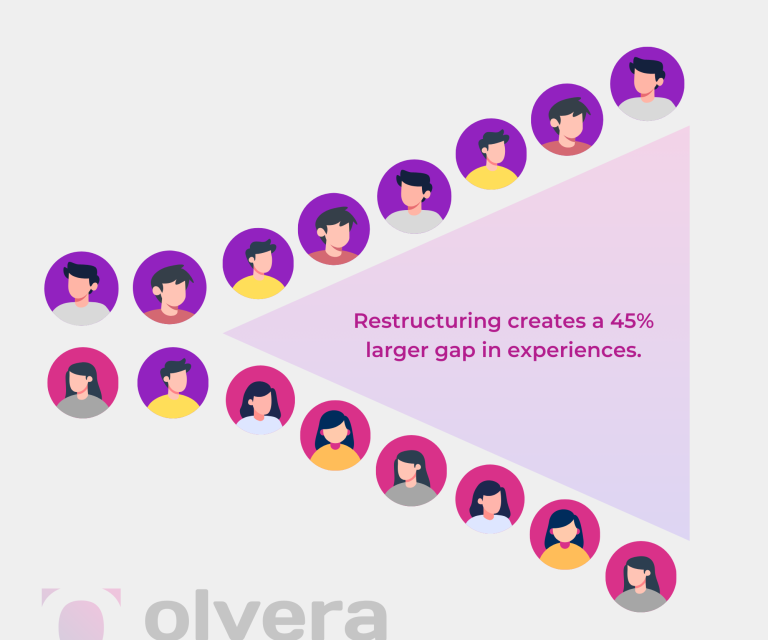Navigating a restructure can be an uncertain time, but the most successful organisations use it as an opportunity to improve on diversity. Why? We have found that organisations that embrace diversity and inclusion have a more open culture that is receptive to change, innovation and improved ideas.
A key component of a successful restructure is the desire to adopt change. Australian businesses have come a long way in building a diverse, equitable, and inclusive workforce, but there’s still more to be done.
In Support of Restructuring This International Women’s Day
Time and time again, we’ve seen how diverse workforces can create a more agile, flexible, and creative organisation. International Women’s Day is a good time to reflect on diversity and inclusion and look at why it’s important when restructuring.
This year’s International Women’s Day centres around the theme #InspireInclusion. It inspires action for gender parity and promotes a world where differences and equity are celebrated. In many Australian companies, we still see women being more susceptible to losing their jobs in a restructure.
Understanding Diversity in the Context of Restructuring
Diversity and Inclusion (D&I) in a workplace is when people from all walks of life are embraced, valued, and treated equally. Embracing a diverse workforce means offering fair selection and employment of people regardless of their gender, ethnicity, race, ability, sexual orientation, and more.
Organisation diversity strategies tend to focus on recruitment, promotions, and remuneration. But it’s time company leaders reached beyond the usual methods of D&I and thought about how they could implement it while saving resources and improving employee morale.
Enter restructuring, a viable way forward. Restructuring often creates gaps in the company, which opens a chance to reassess areas that could benefit from more diverse teams.
Not surprisingly, studies show that women and minorities typically have a poorer employee experience when a company restructures. Additionally, companies that restructure create an alarming experience gap that’s 45% larger than companies that don’t.

As companies prepare for a year of changes ahead, it is tempting to place D&I efforts as a lesser priority over basic needs such as maintaining productivity and reducing costs. However, workforce consolidation is a critical priority in restructuring and can be done together with D&I.
According to a 2023 report by the Australian HR Institute, there is an apparent disconnect between D&I intent and practice. 84% of HR professionals claim that D&I is essential for organisational success, but only 50% say that their leaders see it as a priority.
Why should we think of diversity when restructuring?
Organisations that seek out diversity during a restructure can reap many benefits. Here are some of the key ones.
Increased financial performance
A diverse workforce has been shown to correlate positively with a company’s financial performance. This is unsurprising, considering diverse teams demonstrate improved creativity and innovation.
Research by McKinsey shows that companies with higher gender diversity in executive teams were 21% more likely to experience above-average profitability and value creation.
A boost to employee morale
Restructuring can be a challenging time for employees. Organisation leaders who restructure with D&I in mind can improve their morale by showing that they understand workforce complexities and are not motivated by bias.
Around 76% of Australians claim that diversity is important in the workplace. Working in a diverse environment ensures employees feel valued in their unique experiences and backgrounds, contributing to increased satisfaction.
Improved productivity
A diverse organisation signals leadership that’s open to communication and different ideas, so it’s no wonder that diverse companies are more productive. Companies with more than 30% women executives are more likely to outperform their counterparts with only 10% to 30% women.
Diverse teams are better at problem-solving and creativity. When restructuring, these skills are key to success.
Positive reputation
Most companies must consider public relations following a restructuring exercise and take active steps to manage their reputation. In society today, companies are held accountable for their D&I efforts, even during a restructure.
Businesses that can show their ability to set aside potential bias in decision-making, particularly in compensation, redundancy, and work arrangements, can turn around their image during a restructuring.
Strategies for promoting D&I in restructuring efforts
So, how do businesses effectively balance D&I goals during restructuring? Consider some of these best practices.
- Diversity is a top-down approach that requires commitment from company leaders.
- Identify and dismantle any unintended systemic barriers to diversity. Flexibility (both ways) is the key.
- Be careful not to only ‘check the box’ when restructuring for diversity.
- Organisation leaders should address personal biases during restructuring and ensure that decision-makers come from diverse backgrounds.
- Encourage open communication with employees through feedback and empathy.
- Engage in a consultant who can provide an external viewpoint.
- Organisation leaders should assess the effect of the restructuring on the company’s existing D&I strategy.
Diversity and inclusion initiatives shouldn’t have to take a back seat during restructuring if they are adopted into the company’s everyday operations. Instead of looking at D&I as merely an initiative, it should be a comprehensive process that helps companies move forward from a restructuring effectively.
Olvera Advisors helps businesses stay ahead in a dynamic business environment with bespoke restructuring solutions. Explore our blog for more insights on navigating the financial complexities of restructuring.
References:
- How to Restructure Your Organization with DEI at the Forefront
- Restructuring Your Organization Post-Pandemic? Maintain DE&I Commitments
- Diversity wins: How inclusion matters
- Delivering through diversity
- 76% of Australians say a diversity policy is important to them: survey
- The State of Diversity, Equity and Inclusion in Australian Workplaces




